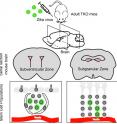Neural stem cells in adult mice also vulnerable to Zika
Zika infection kills off neural stem cells in adult mice bred to be vulnerable to the virus, researchers at the Rockefeller University and the La Jolla Institute for Allergy and Immunology report August 18 in Cell Stem Cell. It has yet to be studied whether the death of these cells has any short or long-term effects in the rodents. Most human adults don't show symptoms when infected with Zika, aside from a fever or rash. Increased incidence of Guillain-Barré Syndrome has been associated with the virus, raising questions about whether Zika has a negative impact on the adult brain. The virus is known to be particularly attracted to neural stem cells, but adults have smaller populations of these cells compared with a developing embryo.
"We wondered if Zika would have more of an effect on newly generated neurons than any other parts of the adult brain," says Joseph Gleeson, a physician who studies brain disorders at The Rockefeller University. "We found that there is something special about these precursor cells that allow the virus to gain entry and dramatically affect their proliferation."
He collaborated with Sujan Shresta, who studies infectious disease at the La Jolla Institute for Allergy and Immunology, after hearing her give a lecture to students on the mouse models she's developed for Dengue virus. Compared to Dengue, Zika has some unique traits (e.g. it crosses the placenta, it is sexually transmitted, it stays in the body), but because both are closely related flaviviruses, the researchers collaborated on adapting the work to the immediate call to action on Zika.
Shresta's lab created the Zika mouse models by knocking out the antiviral molecules that naturally help mice resist infection. The researchers then injected a modern Zika strain into the bloodstream. Three days later the brains of the mice were harvested and antibodies were used to identify the presence of Zika. The investigators observed that viral particles were surrounding the neural stem cells. Looking at brains over time, there was a 4- to 10-fold drop in adult stem cell proliferation.
"Adult neurogenesis is implicated in learning and memory," Shresta says. "We don't know what this would mean in terms of human diseases, or if cognitive behaviors of an individual could be impacted after infection."
The collaborators will next be investigating changes in neural stem cell populations over time in the mouse brain as well as whether the strain of Zika impacts results.
Source: Cell Press
Articles on the same topic
- Neural stem cells control their own fateThu, 18 Aug 2016, 20:14:29 UTC
- Zika infection may affect adult brain cellsThu, 18 Aug 2016, 18:47:25 UTC
- Yale study identifies how Zika virus infects the placentaThu, 18 Aug 2016, 18:46:33 UTC
Other sources
- The Zika Virus in South Floridafrom NY Times HealthSat, 20 Aug 2016, 2:21:13 UTC
- Zika infection may affect adult brain cells, suggesting risk may not be limited to pregnant womenfrom Science BlogFri, 19 Aug 2016, 1:41:10 UTC
- Zika Might Affect Adult Brains, Too, Study Findsfrom MSNBC: ScienceThu, 18 Aug 2016, 23:21:17 UTC
- Yale study identifies how Zika virus infects the placentafrom Biology News NetThu, 18 Aug 2016, 22:51:13 UTC
- Zika kills vital nervous system cells in adult mice, study findsfrom UPIThu, 18 Aug 2016, 20:11:10 UTC
- Study identifies how Zika virus infects the placentafrom Science DailyThu, 18 Aug 2016, 18:32:00 UTC
- Zika infection may affect adult brain cellsfrom Science DailyThu, 18 Aug 2016, 18:31:32 UTC
- Neural stem cells control their own fatefrom PhysorgThu, 18 Aug 2016, 17:31:27 UTC
- Neural Stem Cells Control Their Own Fatefrom Newswise - ScinewsThu, 18 Aug 2016, 17:31:12 UTC
- Zika infection may affect adult brain cells, suggesting risk may not be limited to pregnant womenfrom The Rockefeller UniversityThu, 18 Aug 2016, 16:02:02 UTC
- Yale study identifies how Zika virus infects the placentafrom Science BlogThu, 18 Aug 2016, 15:01:27 UTC
